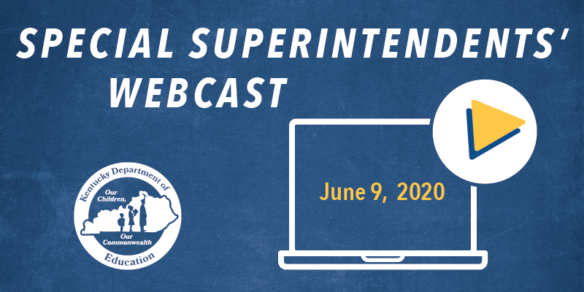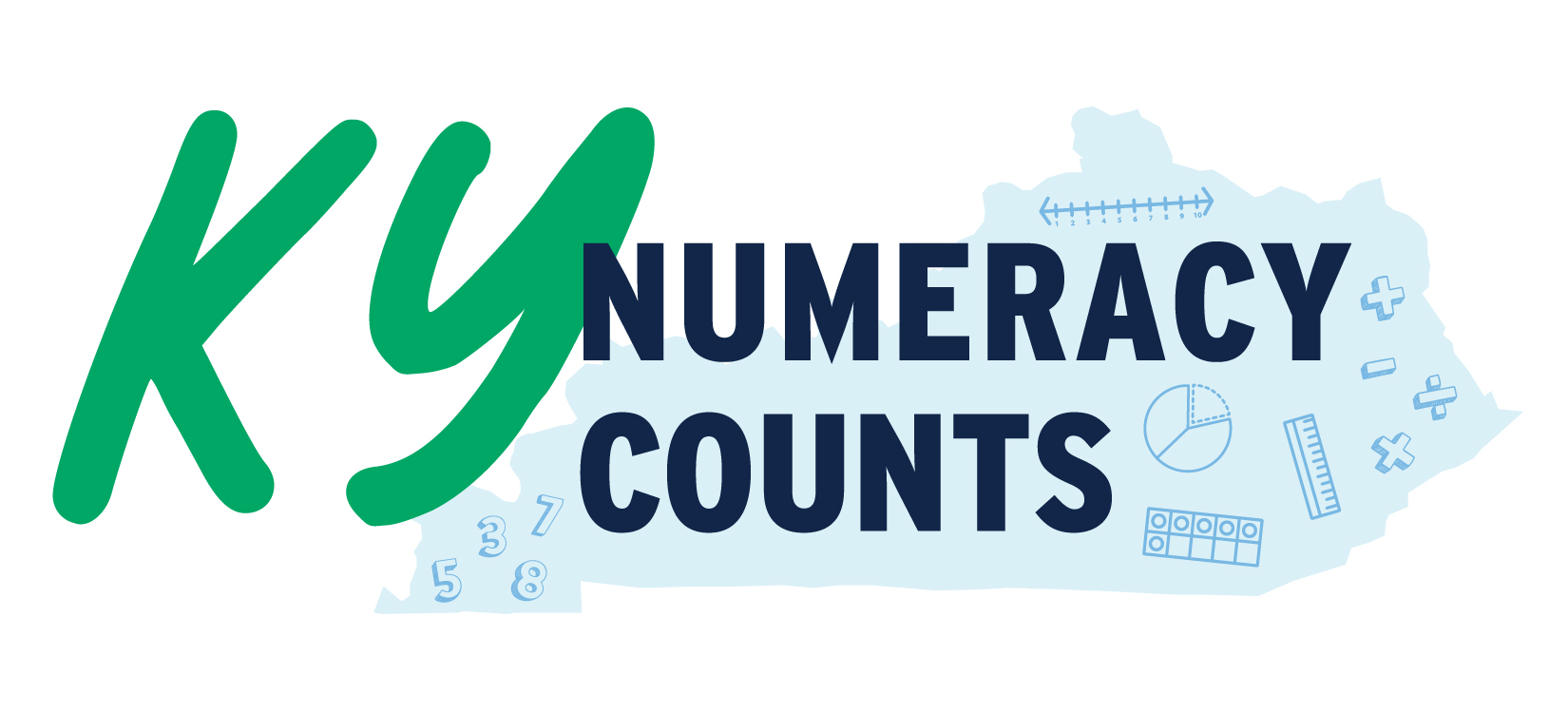
- DPH is currently working on a guidance document and will meet with leadership from the Kentucky Department of Education June 12 to, as Interim Education Commissioner Kevin C. Brown said, “hone the guidance.”
- Lt. Gov. Jacqueline Coleman joined the virtual meeting to assure superintendents that their concerns are being taken into consideration as final public health guidance is developed.
By Jacob Perkins
Jacob.perkins@education.ky.gov
Officials from the Kentucky Department for Public Health (DPH) joined the June 9 Special Superintendents’ Webcast on COVID-19 to answer questions from Kentucky’s superintendents about reopening schools this fall.
DPH is working on a guidance document and will meet with leadership from the Kentucky Department of Education (KDE) June 12 to, as Interim Education Commissioner Kevin C. Brown said, “hone the guidance.”
“As these plans have developed, we are expanding our collaboration,” said Emily Messerli, immunization branch manager for DPH. “We will be getting the documents and the guidance out to you all as soon as possible.”
Messerli told superintendents that a timeline for release will be established during the June 12 meeting.
Whenever the Healthy at School guidance is released and districts begin to implement their reopening plans, DPH urged superintendents to be cognizant of reopening plans already established within their local communities.
DPH already has implemented Healthy at Work guidance and, according to Messerli, schools should follow similar protocols when it comes to masks, social distancing and group gatherings.
KDE previously recommended that districts consider three possibilities for when the next school year might start:
- An early start, perhaps as early as late July;
- A traditional start; and
- A late start, perhaps after Labor Day.
Brown told superintendents that as of June 9, he feels districts can begin to look at starting in a traditional time frame or a late start – assuming the guidance that will be released from DPH is followed. However, districts should be prepared to switch to non-traditional instruction (NTI) if need be.
“We hope you don’t have to pivot to complete NTI next semester at all,” said Brown. “But we know that you need to be ready to do that just in case there’s a spike.’
Brown said some of Kentucky’s districts have begun to develop hybrid models of instruction due to the concerns of families within the community.
During the June 8 Superintendents Advisory Council, Woodford County Superintendent Scott Hawkins said his district has surveyed parents about reopening. Based on some of the responses, Woodford County has determined some of its families are not comfortable sending their children back to school in the fall.
One of the ways the Commonwealth has worked to alleviate some concerns is through the contact tracing program.
The contact tracing program is an online tracking system that allows public health workers to record individual information of Kentuckians who have been exposed to COVID-19, conduct outreach and monitor wellness.
Messerli said if superintendents communicate the program with the families within the district it could, “allay some of the fears of parents and students as they come back to school in the fall.”
Alternative Learning Strategies for Reopening Schools
KDE Chief Digital Officer Marty Park joined the superintendents’ to discuss new guidance released by the department on June 8 about ways to safely structure instruction and learning when schools reopen in the fall.
The document explores a variety of learning and instruction models for districts to consider that prioritize safety during the pandemic, along with learning progression. The guidance encourages each district to consider the options and design a strategy that works best for them.
The document provides four different possible strategies:
- Scheduled Rotation would assign students to groups, and each group would attend in-person instruction at different times.
- Synchronous Opt-In Hybrid would allow parents to choose whether their child learned in-person or remotely.
- Combination would combine the first and the second strategies, allowing for students to learn in-person and remotely at varying times.
- Online and Virtual Learning would expand online learning experiences for students at home.
Each strategy has several considerations, including student and teacher groupings, student ages, time of day and the ability to adhere to COVID-19 health guidelines from the U.S. Centers for Disease Control and Prevention.
“As other leaders have shared an identical position, no one should have the delusion that this is somehow an ideal situation. … Or, more specifically, that technology is a replacement for a physical environment,” said Park. “We’ve always said that if we had to pick between an amazing teacher and technology, the amazing teacher wins every time.
“However, our current scenario certainly dictates that we can find new and improved ways to support our amazing teachers with education technology that works.”
As the situation with the pandemic evolves, KDE is creating new guidance documents to meet the needs of Kentucky’s schools and districts. More guidance and resources can be found on KDE’s COVID-19 website.
Update on Commissioner Search
KDE’s Interim Director of Communications Toni Konz Tatman provided a brief update on the search for the next commissioner of education.
At its June 4 special virtual meeting, the Kentucky Board of Education (KBE) reviewed applications from people interested in becoming Kentucky’s next education commissioner and narrowed the field down to 11 candidates.
Brown is currently serving as interim commissioner of education until a new commissioner is named. Brown, who has been serving in the role since Dec. 18, has said he will not be considered a candidate for the permanent position.
“I have enjoyed this challenge, but I welcome the new commissioner to join and look forward to meeting him or her,” said Brown.
The KBE will conduct interviews for the position June 11-12. The second round of interviews is tentatively scheduled for July 6-7. The board hopes to have a new commissioner in place by late July or early August.
Education Continuation Task Force
Lt. Gov. Jacqueline Coleman, who also serves as secretary of the Education and Workforce Development Cabinet, joined the virtual meeting to discuss how the administration continues to seek input from the K-12 education community on how schools can safely reopen this fall.
Brown announced that the KDE’s Education Continuation Task Force will be adding three new members – Kentucky Association of School Superintendents incoming President Casey Allen, Kentucky Association of School Administrators President Jason Detre and Kentucky School Board Association President Ronnie Holmes. These presidents will join their executive directors, who are already members.
Brown added that Coleman will be reaching out to members of the legislative branch about possibly joining the task force as well.
“I encourage you to continue to share with us your experiences, your concerns and your solutions so that we can make sure that every district is able to create the best plan possible,” said Coleman.
The Education Continuation Task Force will meet every other week, alternating weeks with the Superintendents Advisory Council.
MORE INFO …
- June 9 Special Superintendents’ Webcast
- Kentucky Department for Public Health’s COVID-19 webpage
- KDE’s COVID-19 webpage
- COVID-19 Hotline (800) 722-5725




Asa a school bus driver of 33 years I feel putting 70 students on a bus is not the ideal situation at this time. Maybe split the grades and have a few at a time. There is no win win solution to this problem. As a parent of 2 granddaughters I don’t feel comfortable putting my girls back in school this fall. I would rather they be on remote and be home safe and sound.